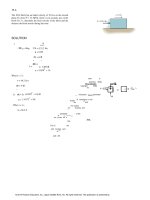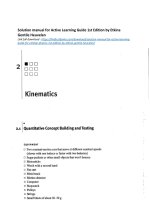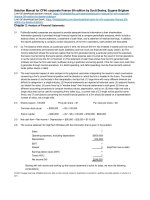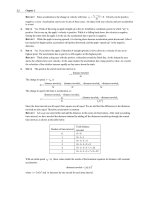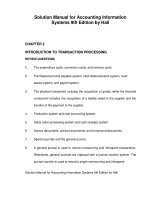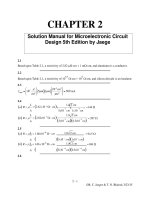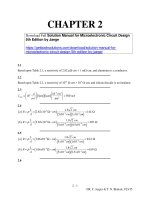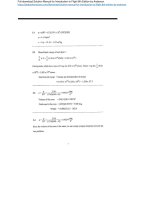Solution manual for applied circuit analysis 1st edition by sadiku
Bạn đang xem bản rút gọn của tài liệu. Xem và tải ngay bản đầy đủ của tài liệu tại đây (540.37 KB, 11 trang )
Instant download and all chapters of Solution Manual for
Applied Circuit Analysis 1st Edition by Sadiku
CLICK HERE
SOLUTIONS TO “APPLIED CIRCUIT ANALYSIS”
CHAPTER 2
Prob. 2.1
l
1.72 10
8
250
R
2 6
A
1.131
( / 4)(2.2) 10
Prob. 2.2
d2
R
l
l RA
A
R4
0.5
4 10
86
91.325 m
4 1.72 10
Prob. 2.3
l
(1.72 10
6
cm)(4ft)(12in/ft)(2.54cm/in) 209.7 10
R
(2in)(2in)2.54cm/in)
25.81
Prob. 2.4
P
R
8.13
2
A
1200
2
I
2
33.33
6
Prob. 2.5
4
6
6
R
l
l
120
RA
3.427 m A
4
1.2
110 10
10
8
110
Prob. 2.6
RA
6
(1.5)2 10
l
6
600
2.25
1.515 km
8
2.8 10
2.8
Prob. 2.7
2
R
l
RA
A
l
6
2.1 4 (0.4)
2
10
6.6 10
-6
m
4 10
Prob. 2.8
2
R
l
A
RA
410 4 (0.5) 1.61 m
l
50
A semiconductor not listed in Table 2.1.
Prob. 2.9
R
l
R l
A
If we shorten the length of the conductor, its resistance decreases due to the
linear relationship between resistance and length.
Prob. 2.10
R
L, A
A
2L1,
1
r2
2
,
0.5r1
L L
R1
L
1
1
0.2
1
r1
A1 4r12
4
R2
2L1
L2
2r
4
same material,
L1
d, d
0.2
2 L21
8 LL1
1.6
A
2
4 4r22 r41
0.2
l R/
copper
1
Prob. 2.11
Acopper
copper
1.72 10
8
8
Aaluminum
aluminum
l R/
0.61
2.83 10
aluminum
Prob. 2.12
l 2.83 10
R
A
8
4.7 10
20 10
4
3
1.2
Prob. 2.13
Ohm’s law (V = IR) states that the voltage (V) is directly proportional to the current (I).
The graph in (c) represents Ohm’s law.
Prob. 2.14
60
V
R
3
I
1.2 k
50 10
Prob. 2.15
I = V/R = (16/5) mA = 3.2 mA
Prob. 2.16
V
(a) I
12
6 mA R
2 10
12
3
V
(b) I
3
1.94 mA R 6.2
10
Prob. 2.17
I = V/R = 240/6 = 40 A
Prob. 2.18
R = V/I = 12/3 = 4 Ω
Prob. 2.19
V = IR = 30 x 10-6 x 5.4 x 106 = 162 V
Prob. 2.20
V = IR = 2 x 10-3 x 25 = 50 mV
Prob. 2.21
R = V/I = 12/(28 mA) = 428.57 Ω
Prob. 2.22
V = IR = 10 x 10-3 x 50 = 0.5 V
Prob. 2.23
I = 4 x 10-2 x 102 = 4 A
I = 4 x 10-2 x 202 = 16 A
I = 4 x 10-2 x 502 = 100 A
For V = 10,
For V = 20,
For V = 50,
Prob. 2.24
(a) I = V/R = 15/10 = 1.5 A flowing clockwise.
(b) I = V/R = 9/10 = 0.9 A flowing counterclockwise.
(c) I = V/R = 30/6 = 5 A flowing counterclockwise.
Prob. 2.25
(a) V = IR = 4 x 10 = 40 V, the top terminal of the resistor is positive.
(b) V = IR = 20 mA x 10 = 0.2 V, the bottom terminal of the resistor is positive (c)
V = IR = 6 mA x 2 = 12 mV, the top terminal of the resistor is positive
Prob. 2.26
(a) V = 3 + 3 = 6 V
(b) R = V/I = 6/0.7 = 8.6 Ω
Prob. 2.27
(a) G = 1/2.5 = 0.4 S
1
(b) G
25 S
3
40 10
1
(c ) G
6
83.33 nS
12 10
Prob. 2.28
(a) R
10 10
(b) R = 1/0.25 = 4 Ω
(c ) R = 1/50 = 20 mΩ
1
3
100
Prob. 2.29
I
3
2.5 10
G
20.83 S
V
120
Prob. 2.30
R
l2
4 l2
d2
4 l
d d
4 lG
R
4
4
1.72 10
d2
5
d 2.093 10
Prob. 2.31
I
V
8
4 10
2
500 10
3
4.38 10
10
m
4 mA
IR
0.8 V
G
5 mS
Prob. 2.32
(a) For the #10 AWG,
R
600 ft
0.9989
0.5993
1000 ft
(b) For the #16 AWG,
R
600 ft
4.01
2.41
1000 ft
Prob. 2.33
A length must be specified. If we assume l = 10 ft, then R in Ω/1000ft = 0.001 x 100 =
0.1. In this case, AWG # 1 will be appropriate.
Prob. 2.34
(a) Acm
(b) Acm
dmil2
d
20.493 mil
980 dmil2
d
31.3 mil
420
0.02049 in
0.0318 in
Prob. 2.35
(a)
Acm dmil2
(b) Acm
2
(0.012 1000)
144 CM
(0.2 1000)(0.5 1000)
78,540 CM
4
Prob. 2.36
1 mile = 5280 ft
R = 4.016 Ω/1000 ft x 1 mile = (4.016/1000)5280 = 21.20
I = V/R = 1.5/21.20 = 70.75 mA
Prob. 2.37
(a) Blue = 6, red = 2, violet = 7, silver = 10%
R
62 107 10% 0.62 M 10%
(b) Green = 5, black = 0, orange = 3, gold = 5%
R
50 103 5%
Prob.2.38
50 k
5%
(a) R
17 105 10%, i.e. from 1.53 M to 1.87 M
(b) R
20 103 5%, i.e. from 19 k to 21 k
(c ) R
92 108
20%, i.e. from 7.36 G to 11/04 G
Prob. 2.39
(a) 52 = 52 x 100 >> Green, red, black
(b) 320 = 32 x 101 >> Orange, red, brown (c ) 6.8k = 68 x 102
>> Blue, gray, red
(d) 3.2 M = 32 x 105 >> Orange, red, green
Prob. 2.40
(a) 240 = 24 x 101 >> Red, yellow, brown
(b) 45k = 45 x 103 >> Yellow, green, orange
(c ) 5.6 M = 56 x 105 >> Green, blue, green
Prob. 2.41
(a) 0.62 M 10% gives maximum value of 0.682 MΩ and minimum value of 0.558
MΩ.
(b) 50 k 5% gives maximum value of 52.5 kΩ and minimum value of 47.5 kΩ.
Prob. 2.42
(a) 10Ω, 10% tolerance >> Brown, black, black, silver
(b) 7.4 kΩ = 74 x 102 , 5% tolerance >> Violet, yellow, red, gold
(c) 12 MΩ = 12 x 106 , 20% tolerance >> Brown, red, blue
Prob. 2.43
0.25 V
Prob. 2.44
250 V
Prob. 2.45
You connect the light bulb terminals to the ohmmeter. If the ohmmeter reads infinity, it
means there is an open circuit and the bulb is burnt.
Prob. 2.46
The voltmeter should be connected in parallel with the lamp, while the ammeter should be
connected in series.
Prob. 2.47
The voltmeter is connected across R1 as shown below.
V
R1
+
V1
R2
-
Prob. 2.48
The ammeter is connected in series with R2, as shown below.
R1
+
V1
R2
-
A
Prob. 2.49
The ohmmeter is connected as shown below.
R2
ohmmeter
Prob. 2.50
As shown below (see (a)), off state gives infinite resistance, while on state (see (b)) gives
zero resistance
Ω
(a)
Off state gives infinite resistance
(b)
On state gives zero resistance
Prob. 2.51
Electric shock is caused by an electrical current passing through a body.
Prob. 2.52
• Check that the circuit is actually dead before you begin working on it.
•
Unplug any appliance or lamp before repairing it.
•
Refrain from wearing loose clothing and jewelry. Loose clothes can get caught in
an operating appliance.
•
•
Use only one hand at a time near the equipment to preclude a path through the
heart.
Always wear long-legged and long-sleeved clothes and shoes and keep them dry.
•
•
Do not stand on a metal or wet floor. (Electricity and water do not mix.).
Do not work by yourself.
